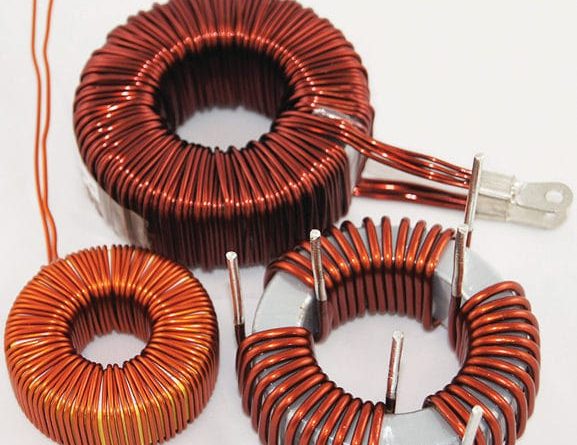Inductor – Different Types of Inductors and Their Uses
Outline:
- Introduction to Inductors
- What is an inductor?
- Inductance and its role
- Air Core Inductors
- Construction and properties
- Typical applications
- Iron Core Inductors
- How the core affects inductance
- Common uses exploiting high inductance
- Ferrite Core Inductors
- Composition and characteristics
- Well-suited applications
- Powdered Iron Core Inductors
- Construction using compressed powders
- Usages capitalizing on permeable core
- Laminated Core Inductors
- Layered construction
- Use cases benefitting from lamination
- Toroidal Core Inductors
- Toroid shape
- Applications of toroidal inductors
- Variable Inductors
- Adjustable inductance
- Circuits utilizing variable inductance
- Audio Frequency Inductors
- Optimized for audio range frequencies
- Audio circuits using AF inductors
- Radio Frequency Inductors
- Designed for radio frequency ranges
- RF circuits exploiting RF inductors
- Multilayer Inductors
- Stacked construction
- Tight space applications
- Molded Inductors
- Encased coils
- Versatile general-purpose uses
- Coupled Inductors
- Inductively linked coils
- Energy transfer and isolation applications
- Thin Film Inductors
- Layers deposited on substrates
- Miniaturized electronics applications
- Color Coded Inductors
- The value indicated through color bands
- Applications where color codes are helpful
The Different Types of Inductors and Their Uses
Inductors are passive components that store energy in magnetic fields and are essential elements of electronic circuits. But what types are available, and makes each suitable for specific applications? Here, we’ll provide an overview of common inductor varieties and the distinguishing properties that make them advantageous for particular use cases.
Introduction to Inductors
Inductors are among electrical and electronic circuits’ most common and valuable components. They are devices that store energy as a magnetic field when an electric current flows through them. They also oppose any change in the current that causes them to create the magnetic field. This property is called inductance, measured in henrys (H).
Inductors have many applications in various fields and industries, such as filtering, sensing, power conversion, signal processing, communication, and more. However, not all inductors are the same. Different types of inductors have different characteristics, advantages, and disadvantages. This blog will explore some of the most common types of inductors and their uses.
An inductor is a coil of wire that creates self-induced electromagnetic fields when current flows through it. It stores energy in those fields that oppose changes in current. Key inductor characteristics:
- Inductance (L) – Ability to induce voltages proportional to the rate of current change
- Core material – Affects inductance and frequency response
- Physical size – Larger inductors offer higher inductance but take up more space
Inductors are used extensively for filtering, oscillating, tuning, and signal-processing circuits. Let’s examine the main options available.
Air Core Inductors
- The simplest form is constructed as a coil of wire around the air
- No ferromagnetic core means low magnetic field concentration
- Offers low inductance but excellent high-frequency response
Typical applications: radio tuning coils, RF chokes, antenna coils
Iron Core Inductors
- Coil wounded around permeable iron core
- Core significantly concentrates the magnetic field
- Achieves inductance hundreds of times higher than air core
Common uses: filter chokes, transformers, energy storage
Ferrite Core Inductors
- Made of ferrite ceramic with iron oxide blended with nickel, zinc, manganese
- High resistivity allows operation at radio frequencies
- Commonly, a hollow cylindrical core or bead
Well-suited applications: HF/RF transformers, choke coils, EMI suppression
Powdered Iron Core Inductors
- Core formed from compressed iron particles insulated with varnish
- Partial air gaps limit eddy current losses at higher frequencies
- Provides high inductance like iron cores but superior frequency response
Usages capitalizing on permeable core: RF chokes, switching power supplies, RFI suppression
Laminated Core Inductors
- Core fabricated by stacking insulated steel sheets
- Lamination minimizes eddy currents, improving high-frequency performance
- Allows large core cross-sections for high inductance
Use cases benefitting from lamination: power supply chokes, EMI filters, ground fault interrupters
Toroidal Core Inductors
- Core completely encircles toroid (doughnut) shaped coil windings
- Magnetic field entirely contained within the core with no external leakage
- Fewer stray electromagnetic interference fields
Applications of toroidal inductors: audio crossover networks, power inverters, current transformers.
Variable Inductors
- Inductance can be manually adjusted via a movable core or coil
- Allows tuning the resonant frequency of LC circuits
- Used for impedance matching between components
Circuits utilizing variable inductance: radio tuning knobs, impedance matching, basic pinch control light dimmers
Audio Frequency Inductors
- Constructed to function within audio bandwidth ~20Hz – 20kHz
- Audio chokes block high-frequency AC ripple while passing audio signals
Audio circuits using AF inductors: crossovers splitting bands, tone controls, equalizers, filters
Radio Frequency Inductors
- Designed for operation up to hundreds of MHz
- Small coils or multilayer structures avoid excessive resistance
RF circuits exploiting RF inductors: impedance matching, resonant tank circuits, bandpass filters, AC/RF decoupling
Multilayer Inductors
- Formed by stacking concurrent flat spiral coils and connecting vertically through vias
- Allows high inductance values in compact surface mount packages
Tight space applications: RFID tags, power supply decoupling, miniature filters
Molded Inductors
- Coil molded into casing for protection and stability
- Suitable for automated mass assembly
Versatile general-purpose uses: filter chokes, EMI suppression, snubbers, energy storage.
Coupled Inductors
- Two or more inductors nearby that magnetically influence each other
- Allows inductive energy transfer between windings
Energy transfer and isolation applications: transformers, chokes, EMI filters
Thin Film Inductors
- Made by depositing coil-shaped metallic film traces on a substrate like silicon
- Very compact but shallow inductance values
Miniaturized electronics applications: on-chip power supply decoupling for ICs, RF/microwave circuits
Color Coded Inductors
- Inductance value denoted through color stripes
- Handy for prototyping and hobbyist circuits
Applications where color codes are helpful: breadboards, testing, temporary circuits
This overview highlights the diverse inductor options available to choose from based on the requirements of electrical and electronic systems. Their ability to control currents and store energy in magnetic fields makes inductors invaluable components.
Frequently Asked Questions (FAQs)
How does increasing the number of turns affect an inductor?
More turns to increase the magnetic field strength produced for a given current, directly increasing the inductance.
What factors affect the inductance value of an iron core inductor?
The permeability of the core material, number of wire turns, core cross-sectional area, and coil length contribute to overall inductance.
Why use shielded inductors?
Shielded inductors prevent electromagnetic interference emission or coupling that can interfere with sensitive neighboring circuitry.
What are super inductors?
Superconductors made from new nanoscale materials can achieve inductance millions of times higher than conventional inductors. But they currently only operate at extremely low temperatures.
How does inductor core saturation affect inductance?
Saturation occurs when the core cannot support more magnetic field intensity, causing inductance to reduce drastically. Added air gaps in cores combat this effect.
MCQS
1. What is an inductor in electrical engineering?
- An inductor is a passive two-terminal electrical component that stores energy in its magnetic field when current flows through it.
2. What are the basic components of an inductor?
- An inductor typically consists of a coil of wire wound around a core material, which can be air, iron, ferrite, or other materials.
3. How does an inductor work?
- When current flows through an inductor, it generates a magnetic field around the coil. This magnetic field stores energy, which is released when the current changes, opposing any change in current flow.
4. What are the different types of inductors based on their core materials?
- Inductors can have air cores, iron cores, ferrite cores, and powdered iron cores, each with specific properties and applications.
5. What are some common applications of air-core inductors?
- Air-core inductors are used in high-frequency applications like radio tuning circuits and inductors for loudspeakers.
6. How are iron-core inductors used, and where are they typically found?
- Iron-core inductors are used in power supply transformers, inductors for filtering, and various electronic circuits requiring energy storage.
7. What are ferrite-core inductors used for, and why are they suitable for such applications?
- Ferrite-core inductors are commonly used in RF (radio frequency) applications due to their high magnetic permeability, which allows them to work efficiently at high frequencies.
8. Can you explain the importance of inductors in power electronics?
- Inductors are crucial in power electronics for filtering, energy storage, and voltage regulation in devices like DC-DC converters and inverters.
9. What are toroidal inductors, and why are they preferred in some applications?
- Toroidal inductors have a doughnut-shaped core, offering high inductance with low electromagnetic interference, making them ideal for power supplies and audio equipment.
10. Are there surface-mount inductors, and where are they used?
- Surface-mount inductors are compact components soldered directly onto PCBs, commonly found in consumer electronics and telecommunications devices.
11. How do adjustable inductors work, and where are they employed?
- Adjustable inductors have a movable core to change the inductance value. They are used in tuning circuits and RF applications.
12. What role do inductors play in electric motors and generators?
- Inductors are present in the windings of electric motors and generators, where they help control current and magnetic fields.
13. Can inductors be used for energy storage in renewable energy systems?
- Yes, inductors are used in renewable energy systems like solar inverters and wind turbines for energy conversion and filtering.
14. How can engineers calculate the inductance value of an inductor?
- Inductance can be calculated using the formula L = (N^2 * μ * A) / l, where N is the number of turns, μ is the permeability of the core material, A is the cross-sectional area, and l is the length of the coil.
15. What are the future trends in inductor technology and applications?
- Future trends include miniaturization, higher operating frequencies, and improved materials for inductors to meet the demands of emerging technologies like 5G, IoT, and electric vehicles.




